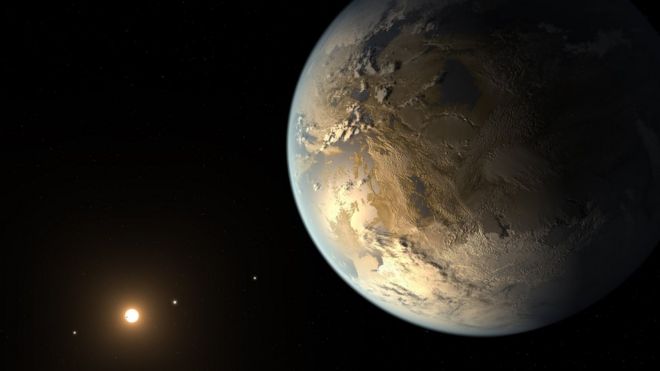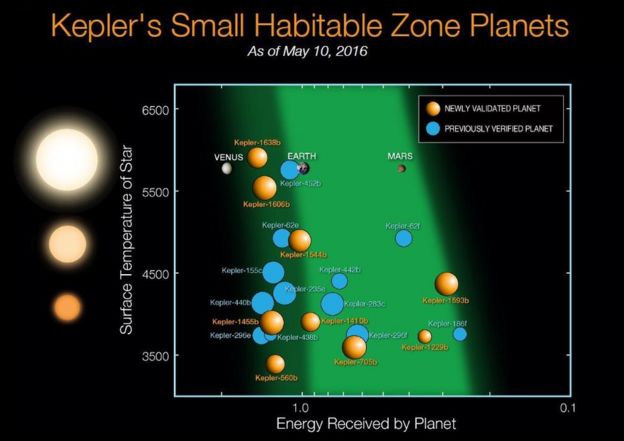Kepler Telescope Discovers 100 Earth-sized Planets - Science/Technology - Nairaland
Nairaland Forum / Science/Technology / Kepler Telescope Discovers 100 Earth-sized Planets (772 Views)
Venus Jupiter Conjunction 2017: The Planets Will Rise As One On Monday / "Human-sized" Fish At Apo Junction In Abuja. Photos / What Will The Sky Look Like If Planets Were As Close To Us As The Moon? (2) (3) (4)
| Kepler Telescope Discovers 100 Earth-sized Planets by lolaxavier(m): 8:27pm On May 10, 2016 |
 Nasa's Kepler telescope has discovered more than 100 Earth-sized planets orbiting alien stars. It has also detected nine small planets within the so-called habitable zone, where conditions are favourable for liquid water - and potentially life. The finds are contained within a catalogue of 1,284 new planets detected by Kepler - which more than doubles the previous tally. Nasa said it was the biggest single announcement of new exoplanets. Space agency scientists discussed the new findings in a teleconference on Tuesday. Statistical analyses of the expanding sample of worlds helps astronomers understand how common planets like our own might be.  Dr Natalie Batalha, Kepler mission scientist at Nasa's Ames Research Center in California, said the calculations so far suggested there could be tens of billions of potentially habitable planets in the Milky Way. "If you ask yourself where is the next habitable planet likely to be, it's within about 11 light-years, which is very close," said Dr Batalha. Astronomers said they consider planets that are 1.6 times Earth's radius or smaller are likely to be rocky, and may therefore be potential targets in the hunt for life. Future telescopes such as the James Webb Space Telescope could analyse the light from the atmospheres of exoplanets for potential markers of biology. Of the telescope's finds to date, the planets Kepler-186f and Kepler-452b are arguably the most Earth-like in terms of properties such as their size, the temperature of their host star and the energy received from their star. Dr Batalha said the new finds Kepler 1638b and Kepler-1229b were intriguing targets in the search for habitable planets. The Nasa Ames researcher said the Kepler mission was part of a "larger strategic goal of finding evidence of life beyond Earth - knowing whether we're alone or not, to know... how life manifests itself in the galaxy and what is the diversity". She added: "Being able to look up to a point of light and being able to say: 'That star has a living world orbiting it.' I think that's very profound and answers questions about why we're here." Dr Timothy Morton, from Princeton University in New Jersey, said the overwhelming majority of exoplanets found by Kepler fell into the super-Earth (1.2-1.9 times bigger than the radius of Earth) and sub-Neptune sized (1.9-3.1 times bigger than Earth's radius). He noted that planets in this size range had no known analogues in our Solar System.  Scientists used a new statistical technique to validate the 1,284 new exoplanets from a pool of 4,302 candidate worlds. The technique involves folded in different types of information about the candidates from simulations, giving the astronomers a reliability score for each potential new world. Candidates with a reliability greater than 99% were designated as "validated planets". The team identified a further 1,327 candidates that are more likely than not to be planets, but do not meet the 99% threshold and will require further study. Kepler employs the transit method to detect planets orbiting other stars. This involves measuring the slight dimming of a star's light when an orbiting planet passes between it and the Earth. The same orbital phenomenon was involved when Mercury passed across the face of the Sun on Monday 9 May. The Kepler telescope, named after the Renaissance astronomer Johannes Kepler, was launched on 7 March 2009. In May 2013, the second of four reaction wheels - used to control a spacecraft's orientation - failed on Kepler. This robbed the orbiting observatory of its ability to stay pointed at a target without drifting off course. However, engineers came up with an innovative solution: using the pressure of sunlight to stabilise the spacecraft, allowing it to continue its planet hunt. The resulting mission was dubbed K2. http://www.bbc.com/news/science-environment-36256725 |
| Re: Kepler Telescope Discovers 100 Earth-sized Planets by johnydon22(m): 11:29pm On May 10, 2016 |
This is wonderful, we are making progress little by little... 1 Like 1 Share |
| Re: Kepler Telescope Discovers 100 Earth-sized Planets by ValentineMary(m): 7:14am On May 11, 2016 |
Really impressive. |
| Re: Kepler Telescope Discovers 100 Earth-sized Planets by Tusweet: 7:39am On May 11, 2016 |
praying harder to see life outside d earth.[i]praying harder to see life outside d earth.[/i]praying harder to see life outside d earth. |
| Re: Kepler Telescope Discovers 100 Earth-sized Planets by lolaxavier(m): 9:39am On May 11, 2016 |
I hope naija can see what other countries are discovering. Instead, na to dey steal we sabi...Book we no sabi sef  |
(1) (Reply)
Maintenance Of Inverter Batteries. / Earth Tremor: 7 Things You Need To Know About The Disaster That Rocked Kaduna / How To Repair A Stubborn Damaged/corrupted Memory Card Easily
(Go Up)
| Sections: politics (1) business autos (1) jobs (1) career education (1) romance computers phones travel sports fashion health religion celebs tv-movies music-radio literature webmasters programming techmarket Links: (1) (2) (3) (4) (5) (6) (7) (8) (9) (10) Nairaland - Copyright © 2005 - 2024 Oluwaseun Osewa. All rights reserved. See How To Advertise. 25 |